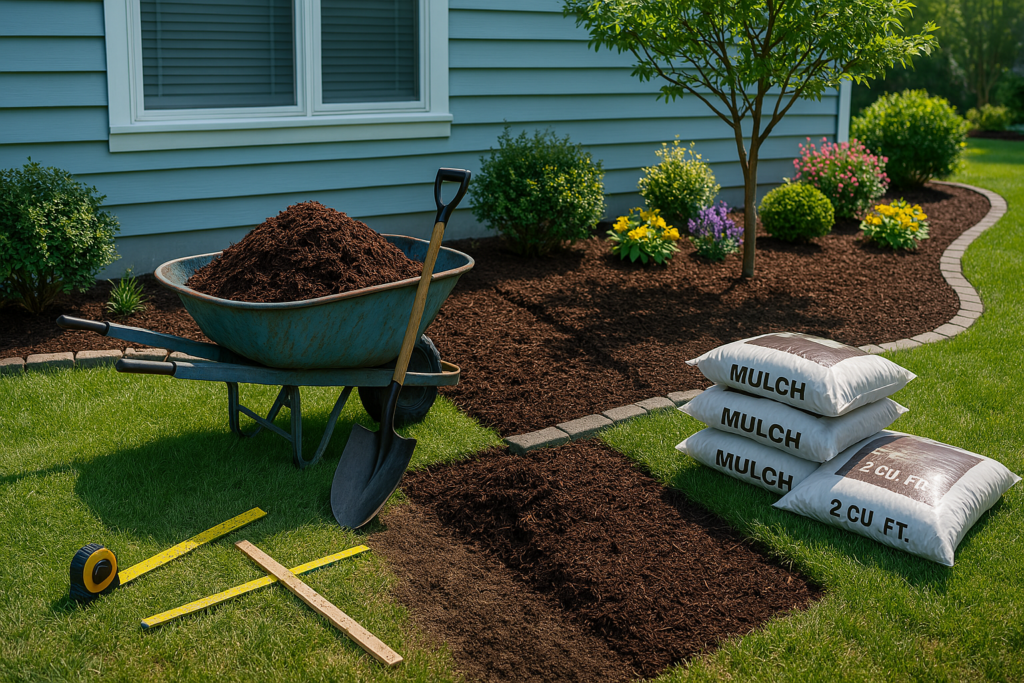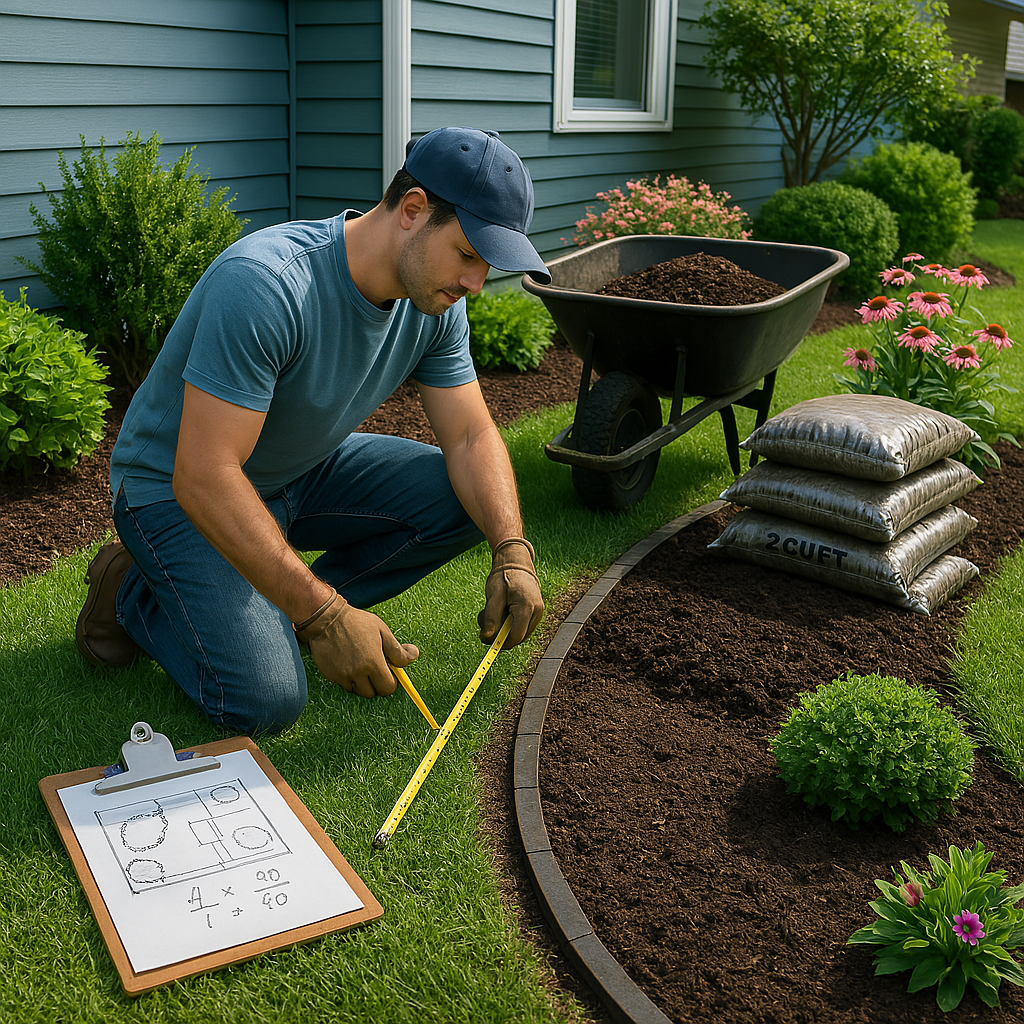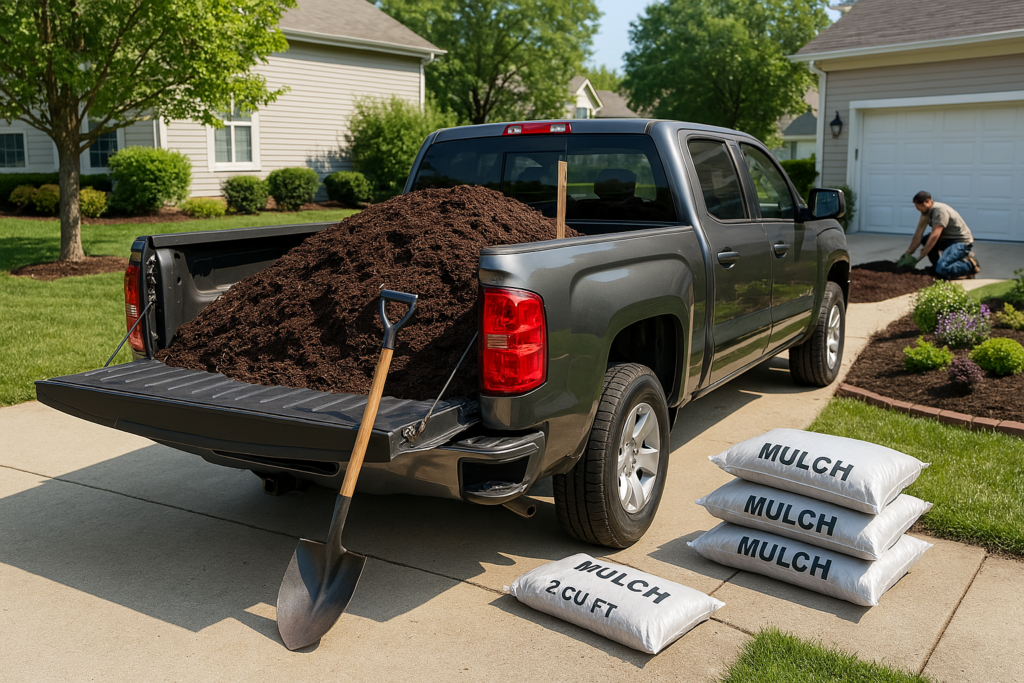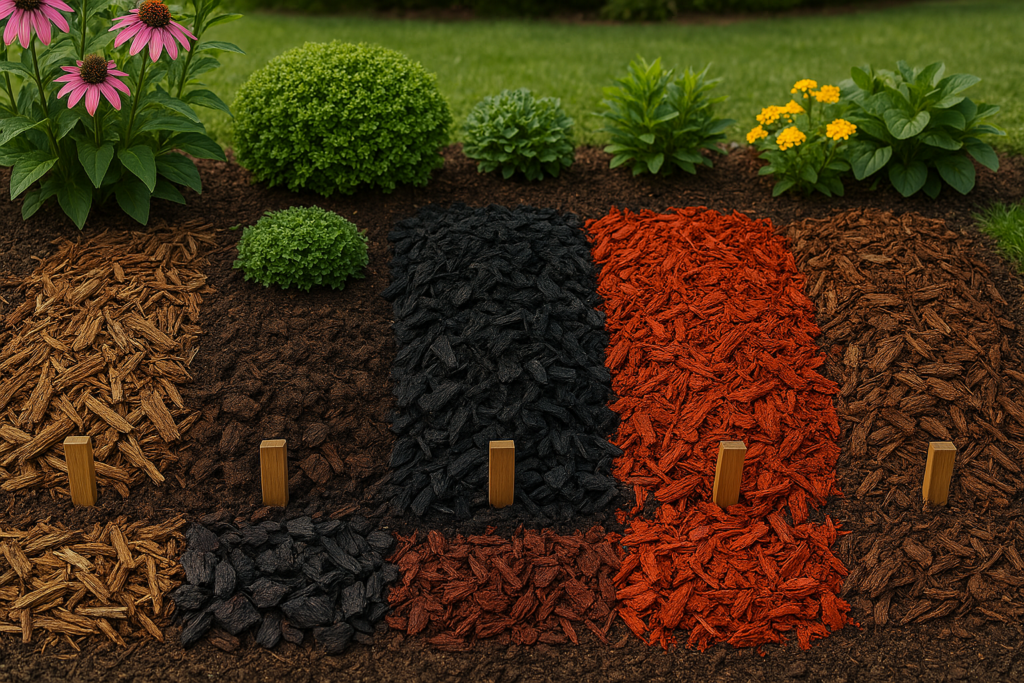How Much Mulch Do You Need? A Complete Homeowner’s Guide
aquaserene
April 11, 2025
- Why Mulch Matters: More Than Just Ground Cover
1.1. Benefits for Soil Health and Plant Protection
1.2. Curb Appeal and Landscape Enhancement
1.3. Weed Control, Moisture Retention, and Erosion Prevention - Understanding Mulch Volume and Measurements
2.1. What Is a Cubic Yard of Mulch?
2.2. Mulch Bag Conversion: Cubic Feet to Yards
2.3. Recommended Depths for Common Landscaping Projects - How to Calculate How Much Mulch You Need
3.1. Measuring Square Footage Accurately
3.2. Depth-to-Volume Conversion Formula
3.3. Fast Reference Chart: Square Feet to Yards
3.4. Real-Life Examples (Beds, Trees, Circular Areas) - Weight and Transport: What a Yard of Mulch Really Weighs
4.1. Mulch Weight by Material Type
4.2. How Moisture Affects Mulch Weight
4.3. What Heavier Products (Topsoil, Stone) Weigh - Truckload and Delivery Logistics
5.1. Pickup Truck Mulch Capacity (By Bed Size)
5.2. When to Pick Up vs. Schedule Delivery
5.3. Preparing Your Property for a Bulk Drop - Bulk vs. Bagged Mulch: What’s Better for You?
6.1. Cost Per Yard Comparison
6.2. Labor, Waste, and Storage Considerations
6.3. Best Uses for Bulk vs. Bagged Mulch - Choosing the Right Type of Mulch
7.1. Dyed Mulch vs. Natural Mulch
7.2. Mulch Recommendations by Project Type (Beds, Trees, Playgrounds)
7.3. Appearance, Longevity, and Soil Impact - Specialty Soil and Mulch Blends
8.1. Nutri-Peat and Organic Soil Conditioners
8.2. Compost-Based Blends for Raised Beds
8.3. When to Mix Soil with Mulch for Better Growth - Frequently Asked Questions About Mulch
9.1. What If I Order Too Much?
9.2. Should I Remove Old Mulch Before Reapplying?
9.3. Can I Mix Different Types of Mulch?
9.4. How Much Mulch Can My Truck Hold? - Final Tips for a Successful Mulch Project
10.1. Avoiding Over-Mulching and Plant Stress
10.2. Best Practices for Edging and Slope Control
10.3. Seasonal Mulch Maintenance and Touch-Ups
Why Mulch Matters: More Than Just Ground Cover

Reading Time: 11-13 Minutes
Mulch does more than make a garden look finished — it plays a critical role in moisture retention, weed control, and overall soil health. Whether you’re refreshing a flower bed or covering a full landscape, one of the most common questions homeowners ask is: How much mulch do I actually need?
This comprehensive guide will walk you through how to calculate mulch volume, what a “yard” really means, how much fits in your truck, and which mulch works best for your landscape. We’ll also help you avoid overbuying or underestimating your needs with real examples and helpful formulas.
Mulch is more than a finishing touch—it improves the function and health of your landscape. Here’s what it does:
Controls Weed Growth
By blocking sunlight and preventing weed seeds from sprouting, a good layer of mulch saves you hours of pulling and spraying. Mulch acts as a natural barrier, reducing your need for chemicals or herbicides.
Retains Moisture
Mulch insulates the soil and slows evaporation, which is especially important in dry seasons or during high summer heat. This reduces how often you need to water.
Regulates Soil Temperature
In hot months, mulch keeps the roots cooler. In winter, it adds a layer of insulation that protects perennials and bulbs.
Prevents Soil Erosion
In sloped yards or rainy climates, mulch helps hold the soil in place, reducing runoff and erosion. It’s particularly effective around newly planted beds and trees.
Enhances Curb Appeal
Fresh mulch gives gardens, walkways, and planting beds a clean, uniform appearance. Whether you choose rich brown hardwood or vibrant black dyed mulch, the contrast makes your landscaping pop.
Understanding Mulch Measurements
Before calculating how much mulch to order, it’s important to understand how mulch is measured — and how those measurements translate to your yard.
What Is a Cubic Yard of Mulch?
A cubic yard is a volume measurement:
1 cubic yard = 3 feet wide × 3 feet long × 3 feet deep = 27 cubic feet
Most mulch suppliers sell mulch by the yard for bulk delivery, or in 2 cubic foot or 3 cubic foot bags at retail.
Mulch Format | Volume |
1 cubic yard | 27 cubic feet |
1 bag (2 cu. ft) | 13.5 bags per yard |
1 bag (3 cu. ft) | 9 bags per yard |
So if your project requires 3 yards of mulch, that’s roughly 81 cubic feet — or about 27 bags of 3 cu. ft mulch.
Mulch Depth Recommendations
Depth makes a big difference in how much mulch you’ll need. Here’s a standard guide based on the area you’re covering:
Project Type | Recommended Depth |
Flower beds | 2–3 inches |
Around trees | 3 inches |
Vegetable gardens | 1–2 inches |
Playground safety zones | 4–6 inches |
Weed suppression zones | 3–4 inches |
Always measure depth after compaction, especially for fresh wood mulch, which can be fluffy when first applied.
Mulch Calculator: How to Measure Your Area Accurately

To determine how many cubic yards of mulch you need, follow this simple formula:
Step 1: Measure the Square Footage
Multiply the length × width of the area you’re mulching.
Example: A 20 ft × 10 ft garden bed = 200 sq ft
Step 2: Decide on Depth
Convert your depth to feet for the calculation. For instance:
- 1 inch = 0.083 feet
- 2 inches = 0.167 feet
- 3 inches = 0.25 feet
Step 3: Use the Mulch Formula
Square feet × depth (in feet) ÷ 27 = cubic yards needed
Example Calculation:
200 sq ft × 0.25 (for 3-inch depth) ÷ 27 = 1.85 cubic yards
Round up slightly to ensure full coverage. In this case, you’d order 2 cubic yards.
Fast Conversion Chart
Area (sq ft) | 2” Depth | 3” Depth |
100 | 0.62 yds | 0.93 yds |
250 | 1.54 yds | 2.31 yds |
500 | 3.09 yds | 4.63 yds |
1,000 | 6.17 yds | 9.26 yds |
Real-Life Examples
Backyard Bed
Size: 15 ft × 12 ft = 180 sq ft
Depth: 2.5 inches (0.21 ft)
Calculation: 180 × 0.21 ÷ 27 = 1.4 cubic yards
Recommended Order: 1.5 to 2 cubic yards
Tree Ring
Diameter: 5 ft (Circle area = πr² → 3.14 × 2.5² = 19.6 sq ft)
Depth: 3 inches = 0.25 ft
Calculation: 19.6 × 0.25 ÷ 27 = 0.18 cubic yards
Recommended Order: 0.25 yard or a couple of bags
How Much Does a Yard of Mulch Weigh?
While mulch is sold by volume (cubic yards), it’s important to understand how much that actually weighs, especially if you’re picking it up yourself or trying to plan for delivery. Different types of mulch and soil vary in density, and moisture can add hundreds of pounds to each yard.
Here’s a general guide to help you plan based on mulch type:
Material | Average Weight (per cubic yard) |
Hardwood Mulch (dry) | 400–600 lbs |
Hardwood Mulch (wet) | 600–1,000 lbs |
Bark Mulch | 500–800 lbs |
Dyed Mulch | 700–1,200 lbs |
Playground Mulch | 800 lbs |
Garden Compost | 800–1,000 lbs |
Mushroom Soil | 1,000–1,200 lbs |
Topsoil | 2,000 lbs (1 ton) |
Sand | 2,500 lbs |
2A Modified/Gravel | 2,500–2,800 lbs |
Pro tip: Mulch that’s been sitting in the rain or delivered early in the morning may be significantly heavier than dry material. This is especially true for dyed or hardwood mulches.
How Much Mulch Fits in a Pickup Truck?

Whether you’re picking up mulch yourself or hiring a supplier to deliver, it’s important to know what fits in a truck bed — so you don’t overload your vehicle or underestimate your order.
General Pickup Truck Capacity (Mulch)
Truck Bed Size | Estimated Mulch Capacity |
6-foot bed (standard) | 2 cubic yards |
8-foot bed (long bed) | 3 cubic yards |
Compact SUV/trailer | 1 cubic yard or less |
Note: These estimates apply to lighter materials like mulch or compost. Heavier loads (e.g., topsoil or stone) may max out your truck’s weight limit before the bed is full.
Should You Pick Up or Get It Delivered?
- Pick Up if you’re ordering under 2 yards, and you have a truck or trailer. This gives you flexibility and may save on delivery fees.
- Schedule Delivery if you’re ordering 3+ yards, or you’re working with heavier materials like topsoil, sand, or gravel. Delivery is more efficient and easier on your vehicle.
Delivery Tips: What to Know Before the Truck Arrives
If you’ve decided to schedule a mulch delivery, make sure your property is ready. Here’s how to prepare:
- Mark the drop zone: Use a cone, tarp, or piece of plywood to indicate where you want the mulch placed.
- Clear the driveway or path: Delivery trucks often need 10 feet or more of clearance to back up and dump materials.
- Protect concrete or pavers: Place plywood under dyed mulch to avoid staining during drop-off.
- Consider weather: Avoid deliveries during rainy days — wet mulch is heavier, harder to spread, and can compress unevenly.
- Mark the drop zone: Use a cone, tarp, or piece of plywood to indicate where you want the mulch placed.
Bulk vs Bagged Mulch: Which One Makes More Sense?
Most local stores offer both bulk mulch (sold by the yard) and bagged mulch (usually in 2 or 3 cubic foot bags). The right choice depends on your project size, delivery logistics, and personal preference.
Factor
Bulk Mulch
Bagged Mulch
Price per Yard
$35–$60/yard (on average)
$4–6 per bag = $65–$90/yard equivalent
Labor Required
Requires wheelbarrow, shovel, tarp
Easy to carry and spread by hand
Waste & Packaging
No plastic waste; delivered loose
Plastic bags must be disposed of
Storage Flexibility
Can be tarped and left in piles
Easier to stack and store neatly
Best For
2+ yard projects, full landscapes
Small beds, touch-ups, spot jobs
Bottom line:
Use bulk mulch if you need more than 2 cubic yards or want to save per yard.
Use bagged mulch if you’re working in small spaces or don’t have delivery access.
Choosing the Right Mulch for Your Project

Dyed vs Natural Mulch: What’s the Difference?
One of the first choices homeowners make is whether to use dyed mulch or natural (undyed) mulch. While both perform the same core functions — moisture retention, weed control, and insulation — they differ in appearance and longevity.
Type
Pros
Cons
Natural mulch
Organic, chemical-free, blends into the soil
Fades faster (especially under sunlight)
Black dyed mulch
Bold contrast, long-lasting color
May fade to gray over time; some dyes not plant-safe
Brown dyed mulch
Natural look with added richness
Can stain concrete if wet at time of delivery
Red dyed mulch
Vibrant and eye-catching for design contrast
May not suit all landscapes or traditional homes
Pro tip: Choose natural mulch for vegetable gardens, and dyed mulch for decorative beds or high-traffic areas where color retention matters.
Best Mulch for Different Uses
Depending on what you’re planting (or protecting), here’s a breakdown of mulch materials tailored to specific landscape applications:
Vegetable Gardens
- Recommended: Natural hardwood mulch, compost blends, or straw
- Why: These break down over time, enriching soil with organic matter
Around Trees and Shrubs
- Recommended: Shredded bark or wood chips (2–4 inches deep)
- Why: These last longer and help retain root-zone moisture
Flower Beds
- Recommended: Dyed mulch for color contrast; finer shredded mulch for annuals
- Why: Finely shredded mulch breaks down faster and won’t smother shallow-rooted flowers
Playgrounds and Pet Areas
- Recommended: Certified playground mulch or engineered wood fiber (EWF)
- Why: Softer, splinter-free, and designed for safety with better impact absorption
Under Decks or Pathways
- Recommended: Coarse bark nuggets or stone mulch
- Why: These resist wind, don’t decompose quickly, and reduce weed growth in low-maintenance areas
Specialty Mulch Options
Some suppliers — including premium yards and local landscape centers — offer specialty blends tailored to specific soil and drainage needs:
Nutri-Peat Soil
- A peat-rich, composted blend ideal for nutrient-poor or compacted soil
- Great for amending garden beds before planting
Soil/Compost Mix
- A balanced mix of screened topsoil and organic compost
- Ideal base for raised beds, lawn repair, or native plant gardens
Mushroom Soil
- A byproduct of mushroom farming, loaded with organic matter
- Best for flower beds, vegetable rows, and moisture-retentive zones
Note: Mushroom soil and compost mixes are not mulches in the traditional sense, but are often used under or with mulch layers for better results.
- Recommended: Natural hardwood mulch, compost blends, or straw
Mixing Mulch with Soil: When It Makes Sense
Sometimes the best approach is to layer or blend mulch with compost or topsoil — especially if you’re revitalizing an older garden or starting from scratch.
When to Blend:
- You’re planting directly into a new bed and want improved soil fertility
- Your native soil is heavy clay, sandy, or nutrient-poor
- You want to build a raised garden bed with both moisture retention and slow nutrient release
How to Do It:
- Mix 2 parts compost/topsoil to 1 part mulch in the planting zone
- Apply pure mulch as the top layer (2–3 inches) to control weeds and retain moisture
- You’re planting directly into a new bed and want improved soil fertility
Frequently Asked Questions About Laying Pavers in Cincinnati
Store the excess under a breathable tarp in a shaded area. You can use it for touch-ups later in the season.
Only if it’s compacted, moldy, or too thick. If the layer is still loose and healthy, just rake and top it off.
Yes natural mulch below, dyed mulch on top is common. Just avoid chemically treated wood if using around vegetables.
A standard 6-ft bed holds up to 2 yards. Larger loads should be delivered, especially for heavy materials like soil or stone.
Sources Used
Mulch Barn. “How Much Product Do You Need? Mulch and Soil Yardages.” MulchBarn.com, 2025. https://www.mulchbarn.com/mulch-calculator.
This Old House. “How Much Mulch Do I Need?” ThisOldHouse.com, 2023. https://www.thisoldhouse.com/gardening/21017662/how-much-mulch-do-i-need.
Bob Vila. “How to Calculate the Right Amount of Mulch.” BobVila.com, March 2023. https://www.bobvila.com/articles/how-much-mulch-do-i-need.
Better Homes & Gardens. “Mulch Calculator and Tips for Buying in Bulk.” BHG.com, 2024. https://www.bhg.com/gardening/yard/mulch/how-much-mulch-do-i-need.
Lowe’s. “How to Build a Retaining Wall.” Lowes.com, May 2023. https://www.lowes.com/n/how-to/build-a-retaining-wall.
Home Depot. “Mulch Calculator & Buying Guide.” HomeDepot.com, 2024. https://www.homedepot.com/c/ab/mulch-calculator/9ba683603be9fa5395fab9013c4296e.
University of Maryland Extension. “Mulch: Functions and Management.” Extension.umd.edu, 2023. https://extension.umd.edu/resource/mulch.
Penn State Extension. “Mulching Landscape Trees.” Extension.psu.edu, 2024. https://extension.psu.edu/mulching-landscape-trees.
USDA Natural Resources Conservation Service. “Using Mulch to Conserve Soil and Water.” USDA.gov, 2023. https://www.nrcs.usda.gov/conservation-basics/natural-resources/soil/using-mulch-to-conserve-soil.
City of Cincinnati. “Residential Yard Waste and Mulch Guidelines.” Cincinnati-oh.gov, 2024. https://www.cincinnati-oh.gov/public-services/yard-waste-and-mulch.
